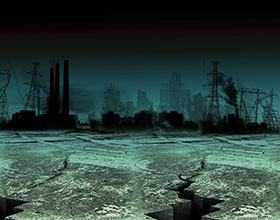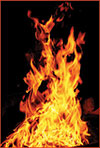

Keeping the power on in Africa is key to the continent’s economic success and the well-being of its people. It’s a 24/7/365 job largely performed by Eskom, which produces approximately 60% of the electricity on the African continent and is the tenth biggest power generating company in the world.
Eskom also carries an enormous responsibility, not least of which is the prevention of fire at its power stations, which could lead to death, injury and the destruction of the facility, says Brendon Cowley, new business director of C3 Shared Services.
For this reason, in 2012, Eskom approached C3 Shared Services, whose list of blue chip clients includes various mines and national key points, to upgrade its Mpumalanga power station, a vast entity with a generating capacity of 2100 megawatts of electricity and an average availability of 92.07% over the last three years.
“Our mandate was to supply Eskom with an early warning system that would detect not only smoke or steam but also flames, so that in the event of an emergency we would be able to evacuate staff in the quickest possible time,” Cowley explains, adding that while all Eskom’s power stations are strongly committed to safety, the Mpumalanga facility has taken “two steps into the future”.
Prevention is critical

The problem with most of the many detection systems on the market today is they are activated once the fire is blazing and consuming its surroundings, the resultant smoke being the alarm trigger, he explains. “Often, it’s not the actual fire that endangers lives but the suffocating smoke caused by the fire, which makes it very difficult to evacuate people.
“Most smoke detectors are limited in that there must be smoke to trigger an alarm. In large areas, the height and volume of the air flow can severely hamper a sensor’s ability to detect smoke.”
These were all factors taken into consideration when C3 designed the new system for the Mpumalanga power station, the result is a bespoke video-based fire and smoke detection system comprising nearly 400 cameras.
“The cameras are programmed to detect and react to flames, which is critical for a power plant as it cannot afford downtime caused by fire damage,” explains Cowley. “The system’s early warning technology gives staff time to react to the fire before it gets out of hand by pinpointing the specific location of the fire.”
Able to detect the presence of flames within their various view fields, the cameras have a built-in intelligence that picks up fire light reflected by other objects which might be in the path of the blaze. The system’s on-screen event display signals, which look similar to CCTV footage, include details of the fire while highlighting flames, smoke, steam and / or reflective heat with blue and red blocks, in keeping with the workings of video analytics.
Each camera can be configured with multiple detection and exclusion zones within its field of view. These zones are set to detect specific events such as fire, smoke and motion. The activation of a zone can also be linked to a time schedule, so for example, an area that releases steam at certain periods of the day can be defined and linked to a schedule, thereby avoiding false alarms.
Full operator control
Because each algorithm runs independently on the camera, operators have wide-ranging flexibility concerning video flame and smoke detection options. Facility managers can easily adjust the sensitivity settings to low, medium, high and even ultra (smoke only), or even turn off an algorithm altogether.
And for post-event investigation purposes, the visual footage allows security managers to identify the cause of the fire, even if the camera is destroyed. Additionally, notes Cowley, the system offers an intruder detection component, making it a valuable asset for security and operational managers.
“Our video-based fire detection camera system has proved to be extremely reliable in the field, saving our clients time and money, not only in terms of reduced downtime but also the costs associated with repairs to damaged equipment and facilities. It’s a powerful and effective alternative to conventional fire products.”
For more information contact C3 Shared Services, +27 (11) 312 2040, marketing@c3ss.com, www.c3ss.com
| Tel: | +27 11 312 2041 |
| Email: | marketing@c3ss.com |
| www: | www.c3ss.com |
| Articles: | More information and articles about C3 Shared Services |

© Technews Publishing (Pty) Ltd. | All Rights Reserved.